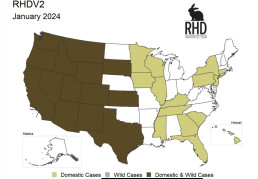RHDV-2: Prevention & Treatment
Rabbit Hemorrhagic Disease Virus 2 (RHDV-2) is a highly contagious and deadly viral infection that affects domestic and wild rabbits. First identified in France in 2010, RHDV-2 has rapidly spread across the world, posing a significant threat to rabbit populations.
RHDV-2 Transmission and Symptoms
RHDV-2 is transmitted through direct contact with infected rabbits, as well as indirect transmission via contaminated food, water, insects or other contaminated objects. In some outbreak areas, it appears to spread along highways, so it’s believed to be moved around on car tires as well. You can also bring it into the home on your clothes and shoes. The virus can survive for extended periods at extreme temps outside the host, making it extremely hardy and easily transmissible. Once inside a rabbit’s body, RHDV-2 attacks the liver and causes internal bleeding, leading to a sudden and often fatal disease course. The typical symptoms of RHDV-2 often resemble classic stasis and include lethargy, anorexia(low or no appetite), fever, respiratory distress, and in some cases, neurological signs. Sometimes the only symptom is sudden, unexpected death. Affected rabbits may die within 12 to 36 hours of showing symptoms. It’s important to have your vet do a necropsy on any rabbit who dies unexpectedly so that there is an accurate representation of disease prevalence in our area.
Prevention of RHDV-2
ALL rabbits are at risk of infection, even if they never go outdoors. Preventing RHDV-2 is essential to safeguard rabbit populations, especially in regions where the virus is prevalent. Several key preventive measures can be implemented:
- Vaccination: Vaccination is the most effective means of preventing RHDV-2. Medgene’s safe and effective vaccine has been widely available since October 2021. Rabbit guardians should consult with their veterinarians to determine the most suitable vaccination schedule for their rabbits.
- Biosecurity: Maintaining strict biosecurity measures is crucial in preventing RHDV-2. Isolating new rabbits, keeping shoes outside, washing hands and changing clothing when handling new rabbits, regularly cleaning and disinfecting enclosures, and preventing contact with wild rabbits are key components of biosecurity.
- Quarantine: Quarantine newly acquired rabbits for a minimum of 21 days to ensure they are not carriers of the virus.
- Limiting Contact: Minimize contact between domestic and wild rabbits, as well as rabbits from different households.
- Monitoring: Keep a close eye on the health of your rabbits and be vigilant for any signs of illness. Early detection can be crucial in containing the spread of the virus.
Treatment of RHDV-2
Unfortunately, there is no specific treatment for RHDV-2. Once a rabbit shows symptoms, the disease typically progresses rapidly, and the mortality rate is extremely high, up to 90%. The focus should primarily be on prevention. Euthanasia is often recommended for affected rabbits to prevent further suffering and to limit the spread of the virus.
Management and Control
Managing RHDV-2 outbreaks is challenging, but there are strategies that can be employed to minimize its impact:
- Disinfection: Thoroughly disinfect cages, equipment, and any area where rabbits were housed or moved. Use appropriate disinfectants to kill the virus effectively. We recommend Rescue brand disinfectant or bleach.
- Containment: Isolate affected rabbits to prevent contact with healthy ones.
- Quarantine: Quarantine newly introduced rabbits and those returning from shows or other events to ensure they are not carriers of the virus.
- Public Awareness: Educate rabbit owners about the virus, its transmission, and the importance of vaccination and biosecurity measures.

